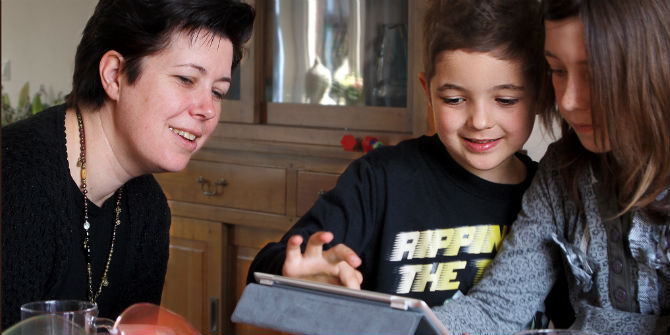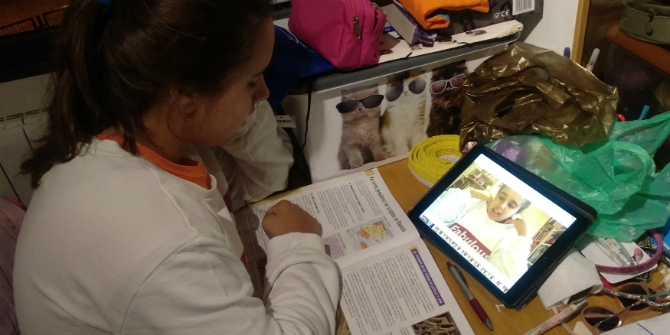 How are young people’s lives changing, particularly in the digital age? Ann Hagell and John Coleman share insights from the Key Data on Adolescence report and look at changes currently impacting young people. Every two years, the Association for Young People’s Health (AYPH) publishes a compendium of publically available statistics about young people’s health, which provides a unique picture of their lives in the round. Ann is a chartered psychologist with a special interest in adolescence and research lead at the AYPH. John is the AYPH Chair, a clinical psychologist, and senior research fellow in the Department of Education at the University of Oxford. [Header image credit: G. Knight, CC BY 2.0]
How are young people’s lives changing, particularly in the digital age? Ann Hagell and John Coleman share insights from the Key Data on Adolescence report and look at changes currently impacting young people. Every two years, the Association for Young People’s Health (AYPH) publishes a compendium of publically available statistics about young people’s health, which provides a unique picture of their lives in the round. Ann is a chartered psychologist with a special interest in adolescence and research lead at the AYPH. John is the AYPH Chair, a clinical psychologist, and senior research fellow in the Department of Education at the University of Oxford. [Header image credit: G. Knight, CC BY 2.0]
After infancy, adolescence is the most rapid phase of growth and change, which has always been the case. Young people have to deal with huge personal changes and emotional growth, but today’s young people are doing this in a world that is also constantly changing.
Social change
Looking at how young people’s lives are changing, there are some notable social changes, some positive good news, and some worrying trends. One finding with particular implications for parents is the proportion of young people over 16 who now stay on at home rather than moving out to live independently – half of those aged 20-24 are still living at home, and this falls to 11% by age 30. And there’s a clear gender difference – with young men more likely still to be home at these ages. It’s not clear what implications this has brought to the parenting task, but no doubt it creates new challenges. For example, is it fair that parents want to know what time a 23-year-old is coming home? Or to worry about where they are and who they are with? When do you text to ask if they are coming back in time for dinner? Can you complain about the amount of time they spend on screens when they are in their 20s? These are adult people living in the household rather than children to be looked after. And parents and young people may have different expectations of the right way to handle things.
ICT use
There were huge shifts in young people’s behaviour relating to the use of information and communication technologies (ICT). In Key Data on Adolescence we presented data from Ofcom suggesting that in 2014, 99% of 16-24 year olds in the UK own a smart phone, compared to 14% of those aged 65+. Although the over-65s will be catching up, young people always lead the charge.
British Audience Research Board data show that the last ten years have seen very little change in the average minutes per day of television viewing by children and young people, and rates are relatively low compared with older adults. What has changed in recent years is young people’s use of the internet. According to Ofcom data, the average 16- to 24-year-old spends over 9 hours every day on media and communication activities, multitasking by using different media and devices at the same time. This includes social networking, but also a range of other activities such as learning, exploring, creating and working. Overuse or particular late evening use of smartphones, tablets and computers have, however, been linked to sleep disturbances in this age group.
Less risky behaviour…
In terms of positive news, Key Data on Adolescence reflect the long-term, downward trends for smoking, drinking and drug use among young people, with rates for these risky health behaviours the lowest they have been since the 1990s, and continuing to decline year on year. Although there are still concerns, with particularly vulnerable groups of young people binge-drinking or taking other risks (such as using new psychoactive substances), these trends are to be celebrated as a public health success. Another positive development is the declining rate of teenage pregnancies, which has halved since the late 1990s.
…but more depression
There is growing evidence, however, that there may be rising levels of anxiety, depression and stress in young people, perhaps particularly among young women in their mid teens, although we lack good representative data on mental health in the general population for this age group, so we should be cautious about drawing conclusions. We looked at hospital admissions for self-harm and self-poisoning, and noted that these have gone up in recent years. The question remains as to how the digital world is playing into these trends. Constant self-comparison and inability to escape the relentless demands of social media, such as pressure to post interesting ‘status updates’, or cyberbullying and teasing, may turn out to be part of the picture, along with other online activities such as risks of grooming or addiction to gambling. But the digital world is only ever going to play a small part, along with many other real-world influences, and indeed, it may also be part of the solution.
Work on delivering help and resilience tools directly to young people’s smartphones is essential, and continues apace, although such work is currently in its early stages.






